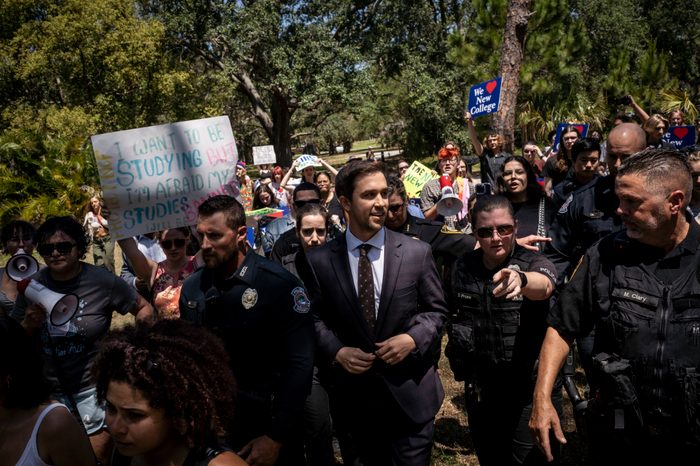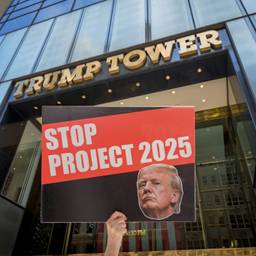Trump, Vance and the Right-Wing Counter-Revolutionaries
The Right’s perennial call for “order” doesn’t necessarily mean affirming the existing order.
Matt McManus

Just before the Fourth of July, Heritage Foundation President Kevin Roberts — who helms the right-wing group most responsible for the Project 2025 plan to transform U.S. institutions and culture — made a revealing declaration. The United States, he said, is currently in the midst of a “second American Revolution,” which may or may not “remain bloodless,” depending on whether “the Left allows it to be.”
If anyone was still in doubt, Roberts’ rhetoric about revolution and mass upheaval demonstrates how the U.S. Right has always had a much more militant strain than neocons and country club Republicans acknowledge. From the John Birch Society’s conspiratorial insistence that Republican President Dwight Eisenhower was secretly a Communist stooge, to Barry Goldwater’s proclamation that “extremism in defense of liberty is no vice,” to Pat Buchanan’s declarations of “religious” and “culture war” at the 1992 Republican National Convention, plenty of high-profile right-wingers have always been willing to declare for radicalism.
In many ways the only thing Donald Trump broke was the carefully curated image of conservative moderatism that could no longer be maintained. Now, not only is what many on the Right call “counter-revolution” in the cards, but it has become the guiding philosophy of conservatism’s intellectual vanguard.
The threat of counter-revolution should not be underestimated. Despite Trump rhetorically distancing himself from the radically transformative Project 2025 and calling for unity after last month’s assassination attempt, his vice presidential pick, J.D. Vance, shows how radical the modern Right’s ambitions are. Vance’s intellectual influences read like a who’s who of modern counter-revolutionary authors. They include Patrick Deneen, who wrote an entire book calling for “regime change” and the installation of a new aristocratic conservative elite; the neo-reactionary monarchist Curtis Yarvin, who’s urged Republicans to get over their “phobia” of dictatorship; and Silicon Valley billionaire donor Peter Thiel, who’s said that democracy threatens capital and that he “no longer believe[s] that freedom and democracy are compatible.”
It should be no surprise that in such a fertile atmosphere many are insisting that “conservatism is no longer enough” and calling for a “counter-revolution” against what they see as a long decaying and decadent liberal order. Distinct from traditional conservatives, right-wingers calling for counter-revolution don’t seek to cautiously manage the changes enacted by liberals and the Left, but react to them with a call to arms; not “standing athwart history yelling stop,” as the old William F. Buckley chestnut goes, but anticipating and struggling for a new kind of illiberal future. In practice many on the U.S. Right yearn to move the county towards the expanding authoritarianism of Viktor Orbán’s Hungary. If they succeed, it will make a mockery of America’s pledge to be a land where all are considered equal.
The idea of counter-revolution
Counter-revolution has a long history in right-wing thought. As political theorist Corey Robin notes in his 2011 book The Reactionary Mind, Europe’s democratic revolutions in the 1700s shocked many who were vested in maintaining the continent’s feudal regimes. What had once seemed like eternal and even divinely ordained aristocratic orders turned out to be eminently fragile, capable of being unmade. But as conservative and reactionary philosophers soon argued, if those aristocratic hierarchies could be unmade, the vulgar new republican societies that were replacing them could also be reversed. Thus the idea of counter-revolution was born, with the mission of undoing the gains made by democratic and egalitarian movements in order to “refound” their countries according to a new and more hierarchical order.
Conservatives of different persuasions, from England’s Edmund Burke to France’s Joseph de Maistre, supported the call, to varying degrees. Maistre — a reactionary who called France’s revolution “Satanic” and predicted the blood of the French king would be paid for with that of four million Frenchmen before the monarchy was restored — was notoriously extreme. But even the comparatively “moderate” conservative Burke shocked his contemporaries, as historian Richard Bourke recounts, with his calls for a relentless and uncompromising war to overthrow the French Revolution, to prevent it from setting an example that other countries might emulate.
Such calls for counter-revolutionary zeal necessarily require conservatives to recognize that they are no longer in the business of conserving the present order, but rather of transforming it or “restoring” something that was lost — through violence if necessary.
The idea of counter-revolution in the United States also has a long history, but one more complicated by the fact that the country was of course born in revolt against the British Empire. But from the beginning, radical moves towards equality in the United States have often been met by resistance and calls for retrenchment, often through a combination of violence and anti-democratic rollback. In the post-Civil War South, for example, the initial optimism of the Reconstruction period gave way to the “Redemption” era’s backlash, in which segregation, the retrenchment of white economic and political domination and mass violence took place.
Today the U.S. concept of counter-revolution is best spelled out in right-wing activist Christopher Rufo’s 2023 book America’s Cultural Revolution. Over the last few years, Rufo has become one of the Right’s major operators, largely responsible for orchestrating right-wing attacks on critical race theory, higher education and diversity, equity and inclusion.

In America’s Cultural Revolution, Rufo makes his ambitions a lot clearer. He argues that while the United States nominally won the Cold War, it was nonetheless conquered, over time, by the radical Left, which undertook a long “march through the institutions” to gain control over academia, the most influential government bureaucracies and the media. Over time, Rufo continued, the Left’s seizure of American culture was demonstrated by the Black Lives Matter protests in 2020. In this catalyzing moment it became clear to Rufo that a “new revolution” had
patiently built itself in the shadows and then, after the death of George Floyd in the spring of 2020, exploded onto the American scene. All of a sudden, the old Angela Davis narrative appeared everywhere: America was an irredeemably racist nation; whites constituted a permanent oppressor class; the country could be saved only through the performance of elaborate guilt rituals and the wholesale overturning of its founding principles. All of the formative institutions — universities, schools, corporations, government agencies — repeated the revolution’s vocabulary like a mantra: “systemic racism,” “white privilege,” “diversity, equity, and inclusion.”
A liberal “new elite” groomed on left-wing ideas had taken control of the country, Rufo argued, inflicting its will on the supposedly right-wing “masses.” In the face of such a cultural routing, conservatives had to realize there was nothing left for them to conserve. Rather, Rufo holds that a new conservative elite must take control to restore the country to greatness.
In a telling 2022 interview with IM — 1776, a “dissident right” magazine that publishes material contemptuous of liberal democracy, Rufo offered a roadmap for such a counter-revolution. In our “post-modern” moment, where the “man who can discover, shape and distribute information has an enormous amount of power,” Rufo explained — in a not-so-veiled reference to himself — the masses could be mobilized by narratives that channel outrage against clear enemies.
As Rufo elaborated in his book, that outrage could ultimately be directed to a higher purpose:
“The task is to meet the forces of revolution with an equal and opposite force, creating new ground for the nation’s common life and reorienting the institutions toward the nation’s eternal principles,” he wrote. “The task is, in short, counter-revolution.”
New order
As the call for counter-revolution has gained traction on the Right, many want to take it even further than Rufo. This spring, Rufo engaged in a testy debate with the influential neoreactionary writer Curtis Yarvin — a once-fringe blogger who’s become a considerable influence on right-wing leaders from Vance to Steve Bannon — over what can be preserved of the liberal project. (Rufo argued for preserving some aspects of U.S. liberalism and republicanism after the counter-revolution, while Yarvin called for a reactionary insurgency to bring about a neo-monarchist order.)
Bannon himself — who recently described the MAGA movement as the means to a “revolution” that will bring about the “total destruction of the deep state” — has promised imminent “revenge” against Trump’s enemies, as soon as Trump has “authority” again.
Both Bannon and Kevin Roberts have also called for purging the government of anyone not on board with their goals while ridding schools and other institutions of “critical race theory” and “gender ideology” — promises that constitute a significant part of Project 2025’s plans to ensure a second Trump term starts strong and retains and expands the conservative movement’s grip on power.
These calls for counter-revolution or to decisively vanquish their enemies demonstrate that the political Right has never truly been about moderation or even conservation, but rather, as Friedrich von Hayek put it, the conviction that there are “recognizably superior” persons in society who are entitled to more wealth, power and status. When the Right has felt satisfied that things are going their way, more moderate forms of conservatism have reigned, and they’ve been satisfied with conserving the status quo. But when threatened with a loss of that superiority, the Right eagerly adopts the language of insurrection and counter-revolution — which are cast as necessities against a Left they claim has come to dominate everything.
It doesn’t matter that this isn’t true. What matters is the potent appeal to a sense of anxiety, resentment, victimization and fear. In his 2004 book Fascists, sociologist Michael Mann notes that Europe’s early 20th century far Right frequently cast democratic advancements as the precursor to full communist takeovers, to justify their own authoritarian ambitions and violent reactions. Today, many on the Right similarly insist the United States is being destroyed by every flavor of Marxism under the sun, as justification of their own plans to use oppressive force against these enemies. (As one example, take far-right pundit Jack Posobiec’s new book Unhumans, which, in true genocidal style, declares radical leftists and Marxists non-human — justifying extreme acts in response — and which boasts a foreword from Bannon and a blurb from Vance.)
Two important truths are revealed by this.
The first concerns the Right’s great skill in appropriating historically Left terms about fighting the ruling class to defend the retrenchment of old hierarchies or the establishment of entirely new ones. In this way, the Right can achieve a kind of pseudo-populist aesthetic that mimics speaking truth to power even as its leaders include a billionaire like Trump and one of the world’s richest men in Elon Musk.
The second is recognizing that the Right’s perennial call for “order” doesn’t necessarily mean affirming the existing order. It’s easy to be perplexed by the fact that conservatives who claim to revere law and order would also vote for a confirmed convict like Trump, praise his running mate for defending Kyle Rittenhouse and support the insurrectionist language of counter-revolution. But Trump and his movement represent a different kind of order: cartoonishly anti-egalitarian, scornful of rationalistic legal restrictions and willing to break whatever rules are necessary to win.
To their followers, as author John Ganz observes, Trump, Vance, Bannon and the rest are celebrated in the same way as The Godfather’s Vito Corleone or Breaking Bad’s Walter White: manly deciders, unbound by constraints, who reward loyalty, dispatch enemies ruthlessly and will restore a patriarchal metaphysical order wherein everyone knows their place in the social hierarchy. Apparently, they forget that mob stories never end without disgrace.
Matt McManus is an assistant professor at Spelman College. He is the author of The Political Right and Equality and The Political Theory of Liberal Socialism, among other books.











